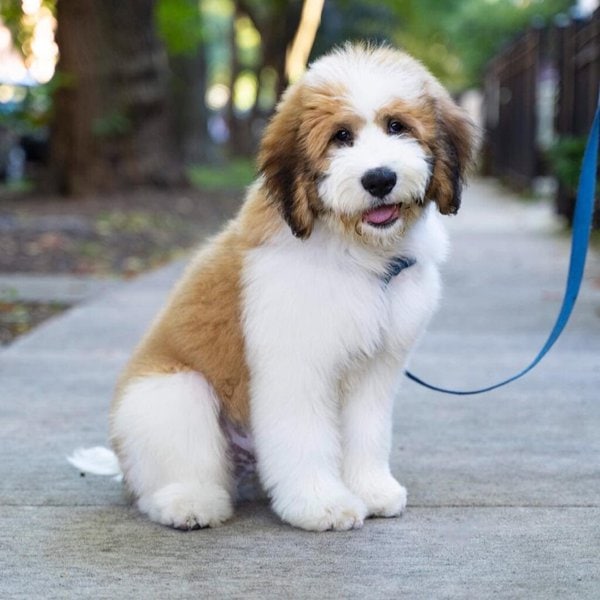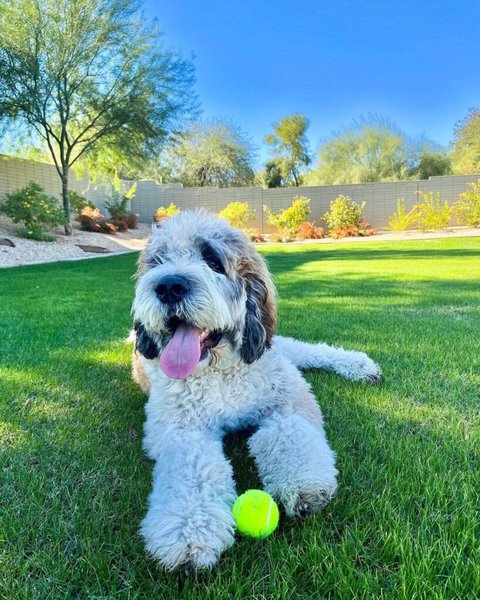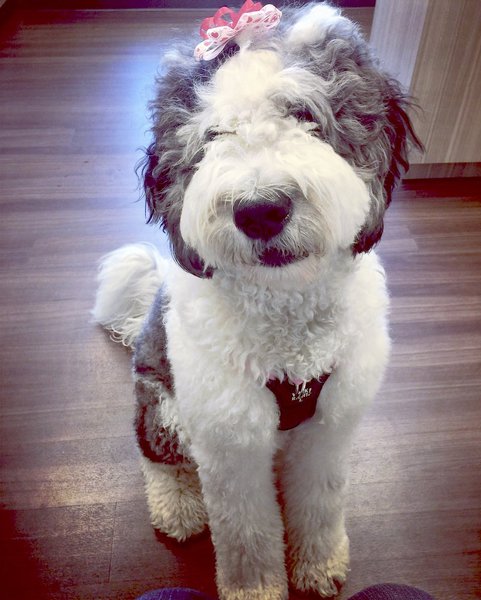In this era of designer dogs, the Poodle is arguably the most popular dog breed for use in mixes. With its low-maintenance hypoallergenic coat, high levels of intelligence, and loving nature, it’s easy to see why. However, some of the pairings are very unusual.
One of these weird pairings is the Saint Berdoodle. This is a mixed dog breed developed from mixing a Standard Poodle with a Saint Bernard. Due to the size differences, the bigger Saint Bernard is used to carry and bear the puppies.
The differences in size and appearance also make it difficult to predict the aesthetic outcome of the mixed Saint Berdoodle puppies. However, as you will see shortly, Saint Berdoodles take after a little of either parent breed in terms of physical traits, health, personality, and care needs.
Without further ado, let’s take a closer look at everything you need to know about the Saint Berdoodle mixed doggy.
How Much Does A St Berdoodle Weigh?
Saint Berdoodles are generally very large dogs that fall somewhere between the giant Saint Bernard and the more medium-to-large Standard Poodle in terms of weight and height.
However, how large the Saint Berdoodle gets depends largely on genetics and some luck.
Here is more on what you can expect from a Saint Berdoodle in terms of size and other distinguishing physical characteristics.
Build And Proportions
The Saint Berdoodle often takes after the bulky build of the Saint Bernard. They are also a bit more proportional in terms of limb length and width compared to height than the narrow and leanly built Poodle.
Weight And Height
In terms of the actual weight that the Saint Berdoodle can grow to, the range is quite large with these mixed pooches being as light as 40 lbs or as heavy as 180 lbs. The height range is also quite wide at 15 to 20 inches.
This all depends on the genetics and size of the contributing Poodle and Saint Bernard parents.
Skull And Facial Features
The facial features and skull structure of the Saint Berdoodle is another aspect of this mix that favors the Saint Bernard parent. Most of these doggies have a wider skull with a wide and shorter snout than the Poodle narrower and elongated features.
Coat Traits
When it comes to the coat traits, it is a tossup between the curly and wiry coat from the Poodle side and the long and smooth coat of the Saint Bernard.
The colors also vary wildly with some Saint Berdoodles having single colored coats in black, white, or shades of brown while others have bicolor or tricolor combinations.

How Long Do Saint Berdoodles Live?
Saint Berdoodles can live for 8 to 12 years. This range is closer to the Saint Bernard’s 8 to 10 years lifespan than the longer Poodle’s 12 to 15 years because Saint Berdoodles large build.
The Saint Berdoodle is generally a healthy dog. However, they do sometimes inherit health issues from either or both parents. Here are some of the most common of these common health issues that Saint Berdoodles face.
Wobbler Syndrome
Wobbler Syndrome is a neurological disease that affects the Saint Berdoodle dog’s spine usually at the level of the neck. The resulting neurologic deficits result in characteristic signs including the wobbling gait that gives the disease its name.
Von Willebrand Disease
Von Willebrand’s disease is an inherited disorder of blood clotting. This leaves the Saint Berdoodle at risk of heavy hemorrhaging as they do not have normal clotting. Fortunately, the disease remains asymptomatic for many Saint Berdoodles, especially if there is no trauma.
Allergies
Saint Berdoodles are prone to developing various allergic reactions. The most common are food allergies and seasonal allergies to things like dust and pollen.
They may also suffer a form of allergic reaction known as contact dermatitis from non-hypoallergenic fabrics and grooming products.
Hip Dysplasia
Hip dysplasia is a condition where the Saint Berdoodle’s hip joint fails to form normally. This results in instability of the joint and could cause chronic pain and inflammation. Eventually, the instability and trauma will result in degeneration of the joints and debilitating arthritis.
Ear Infections
Saint Berdoodles with coats like Poodles often suffer ear infections. This is because the fur grows inside the ear trapping moisture and debris which promote growth and of germs.

How To Take Care Of Saint Berdoodle Mixes?
Saint Berdoodles have very specific care needs that you need to intentionally meet for a happy and healthy doggy. To help you out, here are 3 of the most important points you need to cover for adequate care of your Saint Berdoodle mix.
Feed Your Saint Berdoodle Healthy Food
The Saint Berdoodle is a large dog with a large appetite. As adults, they will need about 4 to 10 cups of food everyday while puppies can chow down as much as 2 to 3 cups of dry dog food a day.
In addition to ensuring they get enough portions to meet their needs, you need to ensure that what you feed them is made from high quality ingredients and is nutritionally balanced.
Pet Plate takes care of these semantics for you based on your dog’s age, breed, and health needs for a customized meal plan made from human-grade ingredients.
Supplement The Diet With Multivitamins
Multivitamin supplements are a great way to add to whatever micronutrients and healthy compounds may be missing in your Saint Berdoodle’s diet.
Get your dog a multivitamin supplement with a blend that takes care of their coat, immune health, gut health, and musculoskeletal health.
Set Aside 1 To 2 Hours A Day For Exercise
Saint Berdoodle dogs have medium to high energy levels. They also really love the outdoors. Therefore, set aside between 1 and 2 hours of your day for an exercise activity with your dog.
This not only helps them work out all their excess energy but also helps keep them fit and mentally engaged.

Are Saint Berdoodles Good Dogs? Temperaments Of Saint Berdoodle Mixes
Saint Berdoodles are fantastic dogs whether you want a family pooch, a companion for a single-person home, or even an adventure buddy. The mix of personality traits from the confident and energetic Poodle and the protective and loving Saint Bernard make for a very versatile dog.
Smart
Saint Berdoodle mixed dogs are quite smart and thus very easy to train. They are naturally curious dogs and are always eager to learn. This comes from the working history both the Poodle and Saint Bernard dogs have which included learning a lot of new skills and commands.
Gentle
The Saint Berdoodle may be a large and intimidating dog but they are the furthest thing from aggressive. In fact the term gentle giant definitely fits these gentle and loving dogs. This makes them great family pets with training and some socialization.
Adventurous
Saint Berdoodles are bred from two dog breeds known for their love for adventure and the outdoors. It therefore should come as no surprise that the Saint Berdoodle mix is happiest outdoors exploring new spots and hanging out with their favorite human.
Energetic
There will never be a dull moment in a home with a Saint Berdoodle. These energetic and goofy dogs are enthusiastic about everything from your arrival home to meal times. They will definitely keep you on your toes.
Protective
Another personality trait that makes the Saint Berdoodle a fantastic family pet is their protective nature. These dogs are particularly protective of young children as well as their adult human companions.

Do Saint Berdoodles Shed? Grooming Tips For Saint Berdoodle Mixes
Whether or not a Saint Berdoodle turns out hypoallergenic depends on whether they inherit the Poodle’s or the Saint Bernard’s coat type. However, most of them take after the long and wavy coat of the Saint Bernard.
As a result, Saint Berdoodle mixed dogs will shed and thus are not considered hypoallergenic. The good thing is that they only shed minimally to moderately and are otherwise low-maintenance.
Here are 2 important coat care tips you need to take good care of your Saint Berdoodle.
Brush The Saint Berdoodle’s Coat 2 To 4 Times A Week
Depending on how heavily your Saint Berdoodle dog sheds, you should brush their fur as little as 2 times a week, to as much as 4 times a week, or even every day if you have a heavy shedder.
This helps get rid of any loose fur and minimize shedding around your home. With the longer-haired Saint Berdoodles, regular brushing also helps to detangle the coat and prevent matting.
For all this, we recommend the Furminator Undercoat Tool whose strong bristles and self-cleaning mechanism make it both efficient and convenient to use.
Wash The Saint Berdoodle Every 4 To 6 Weeks
Like their Poodle parents, Saint Berdoodles rarely get stinky. However, regular washing is important in getting rid of excess oil and other debris on the dog’s coat while also maintaining the brilliance of the coat colors.
Seamus Cherry Blossom Whitening Dog Shampoo is ideal for the job with its whitening formula helping truly highlight the beauty of your Saint Berdoodle’s coat.
Related Questions
How Much Do St Berdoodles Cost? A Saint Berdoodle costs $1,000 to $2,000 depending on the breeder, the availability of a purebred Saint Bernard, and the type of Poodle used. This price is a nice midway point between the Saint Bernard which goes for about $1,500 and Poodles that can go for as much as $5,000.
What Is A Mini St Berdoodle? A Mini Saint Berdoodle is a mixed breed doggy developed from mixed breeding of a female Saint Bernard with a male Miniature Poodle. They are much smaller than the standard Saint Berdoodle. Mini Saint Berdoodles can usually only get as big as 35 to 70 lbs and 18 to 22 inches.
Why Do Saint Bernards Carry Whiskey? Saint Bernard dogs used to carry a small barrel of whiskey around their neck to use to warm up and revitalize people they were rescuing. This is because these doggies were bred and trained specifically for the purpose of use as rescue dogs on mountains and alps. Today, the tiny whiskey carriers are worn for the aesthetic.





